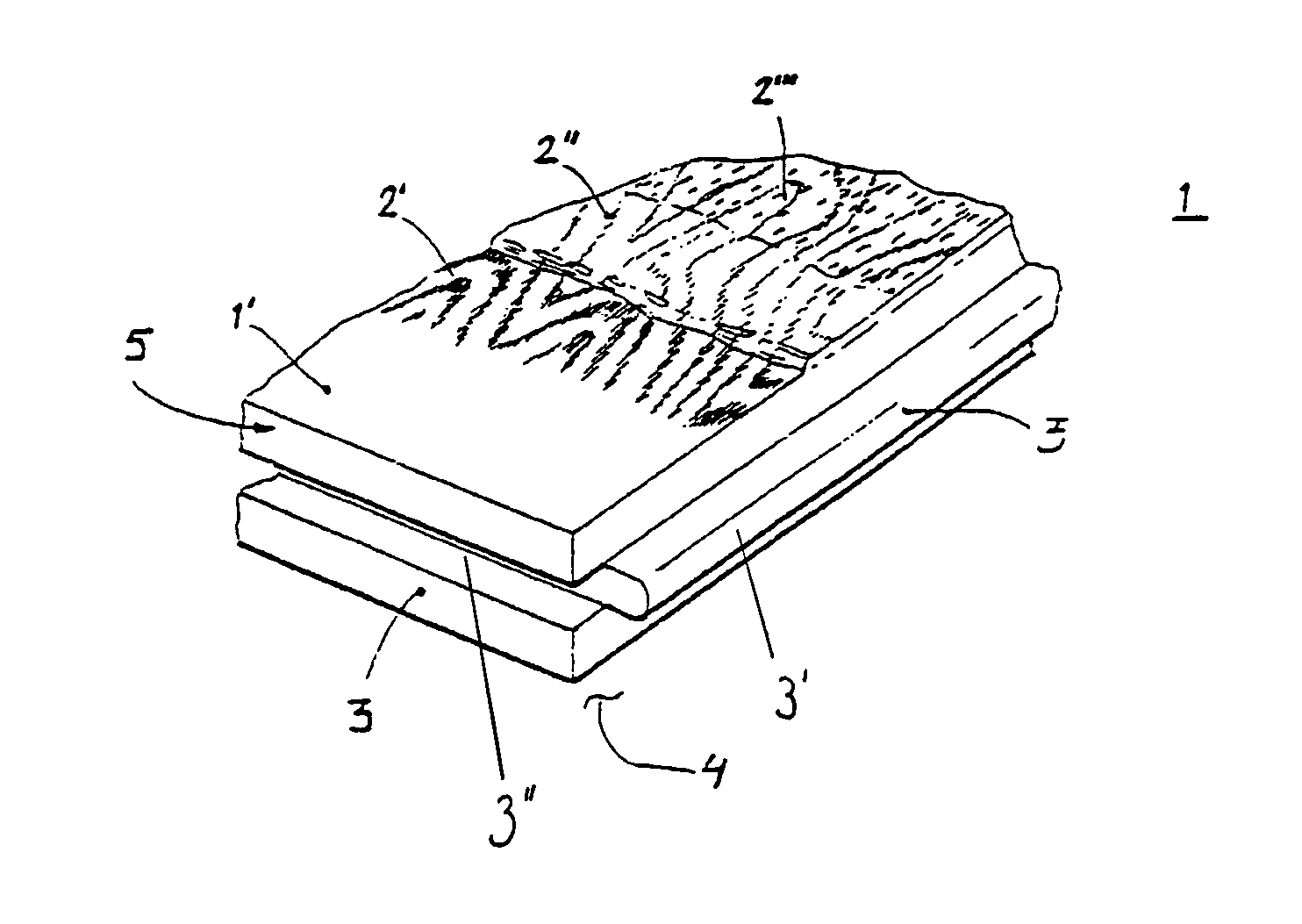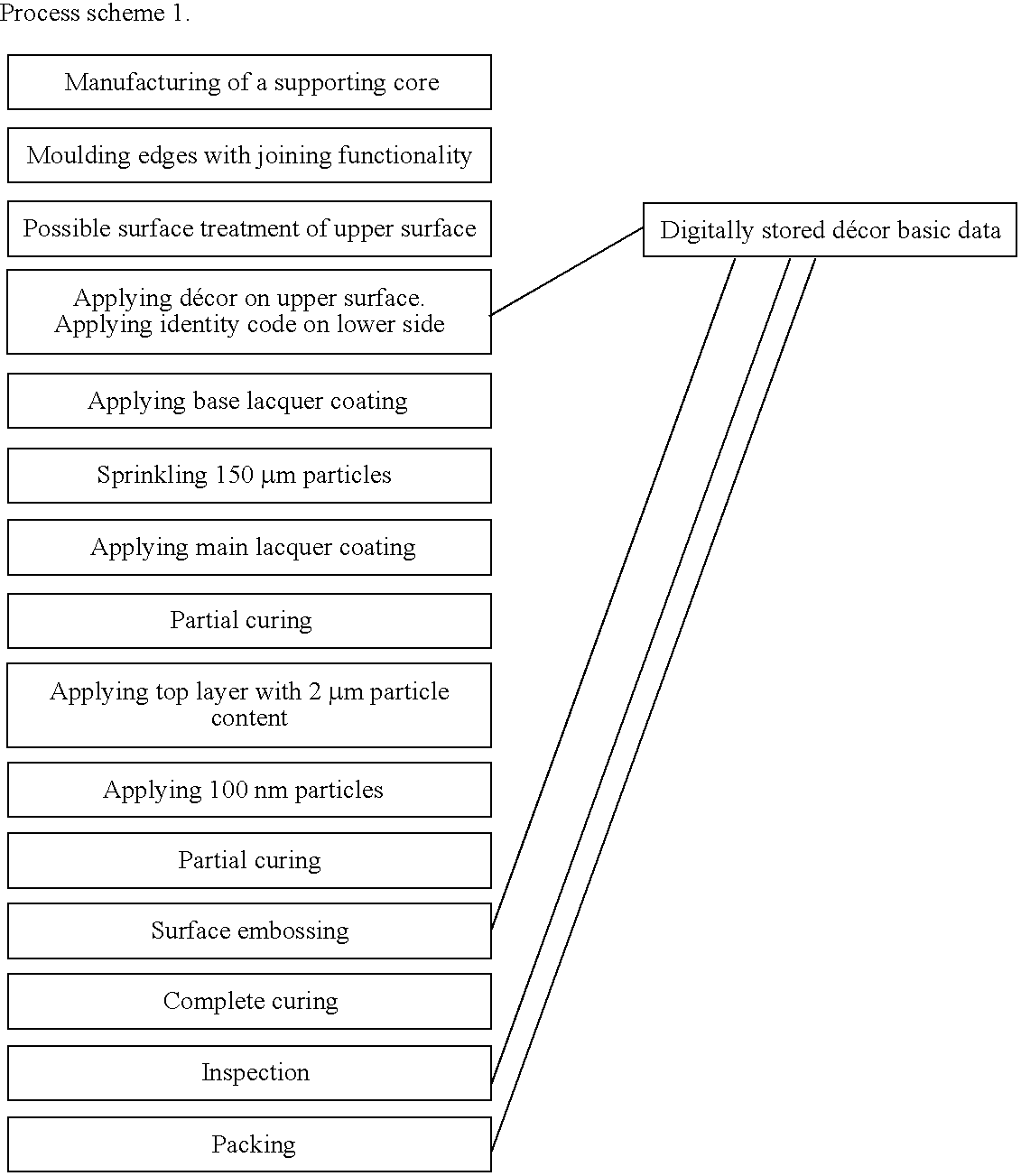Process for achieving décor on surface elements
a surface element and decor technology, applied in the field of decor on the surface element, can solve the problems of large waste of laminate, inability to achieve the desired pattern, and large amount of wasted laminate, so as to achieve the effect of radically reducing the amount of waste and improving the tolerance of décor matching
- Summary
- Abstract
- Description
- Claims
- Application Information
AI Technical Summary
Benefits of technology
Problems solved by technology
Method used
Image
Examples
example 1
[0072]A supporting core of medium density fibre board were sanded smooth. A layer of primer lacquer were applied on top of the fibre board. The primer were cured after which a décor was printed on top of the primer.
[0073]The build up of a wear layer was then initiated by applying 30 g / m2 of UV-curing acrylic lacquer by means of roller coating. 20 g / m2 of hard particles made of α-aluminium oxide with an average particle size of 70 μm were sprinkled on the still sticky lacquer. The lacquer was then exposed to a predetermined energy amount of UV-light so that it cured only partly and the viscosity was increased. Another 30 g / m2 of UV-curing acrylic lacquer was then roller coated onto the already applied layer after which another 20 g / m2 of α-aluminium oxide particles with an average particle size of 70 μm were sprinkled on the still sticky second coating. The lacquer was then exposed to a predetermined energy amount of UV-light so that it cured only partly and the viscosity was increas...
example 2
[0076]A supporting core of medium density fibre board were sanded smooth. A layer of primer lacquer were applied on top of the fibre board. The primer were cured after which a décor was printed on top of the primer. The build up of a wear layer was then initiated by applying 30 g / m2 of UV-curing acrylic lacquer by means of roller coating. 20 g / m2 of hard particles made of α-aluminium oxide with an average particle size of 70 μm were sprinkled on the still sticky lacquer. The lacquer was then exposed to a predetermined energy amount of UV-light so that it cured only partly and the viscosity was increased. Another 30 g / m2 of UV-curing acrylic lacquer was then roller coated onto the already applied layer after which another 20 g / m2 of α-aluminium oxide particles with an average particle size of 70 μm were sprinkled on the still sticky second coating. The lacquer was then exposed to a predetermined energy amount of UV-light so that it cured only partly and the viscosity was increased. T...
example 3
[0081]A supporting core of medium density fibre board were sanded smooth. A layer of primer lacquer were applied on top of the fibre board. The primer were cured after which a décor was printed on top of the primer.
[0082]The build up of a wear layer was then initiated by applying 15 g / m2 of UV-curing acrylic lacquer by means of roller coating. 20 g / m2 of hard particles made of β-aluminium oxide with an average particle size of 70 μm were sprinkled on the still sticky lacquer. The lacquer was then exposed to a predetermined energy amount of UV-light so that it cured only partly and the viscosity was increased. One layer of UV-curing acrylic lacquer was then applied by roller coating and was partially cured as above. The layer had a surface weight of 40 g / m2. The hard particles were embedded in the lacquer after the layer of lacquer was applied and a mainly plane upper wear layer surface was achieved.
[0083]A top coating procedure was then initiated. A first layer of UV-curing acrylic ...
PUM
| Property | Measurement | Unit |
|---|---|---|
| average particle size | aaaaa | aaaaa |
| particle sizes | aaaaa | aaaaa |
| average particle size | aaaaa | aaaaa |
Abstract
Description
Claims
Application Information
 Login to View More
Login to View More - R&D
- Intellectual Property
- Life Sciences
- Materials
- Tech Scout
- Unparalleled Data Quality
- Higher Quality Content
- 60% Fewer Hallucinations
Browse by: Latest US Patents, China's latest patents, Technical Efficacy Thesaurus, Application Domain, Technology Topic, Popular Technical Reports.
© 2025 PatSnap. All rights reserved.Legal|Privacy policy|Modern Slavery Act Transparency Statement|Sitemap|About US| Contact US: help@patsnap.com



